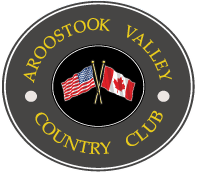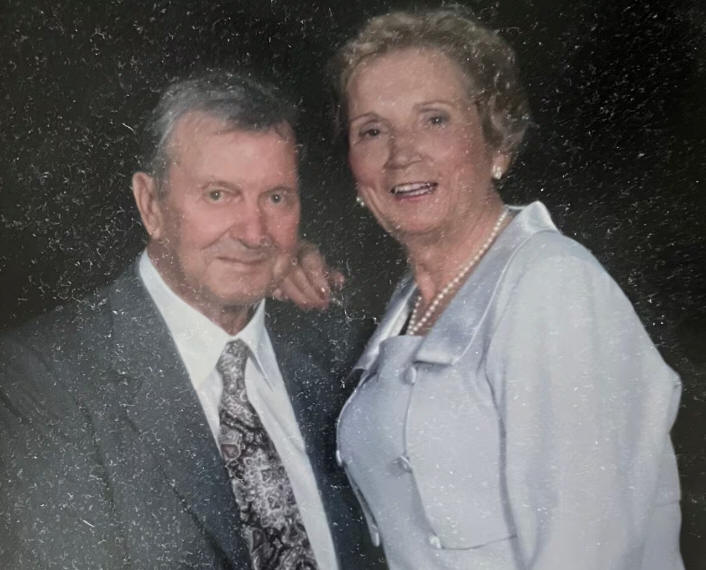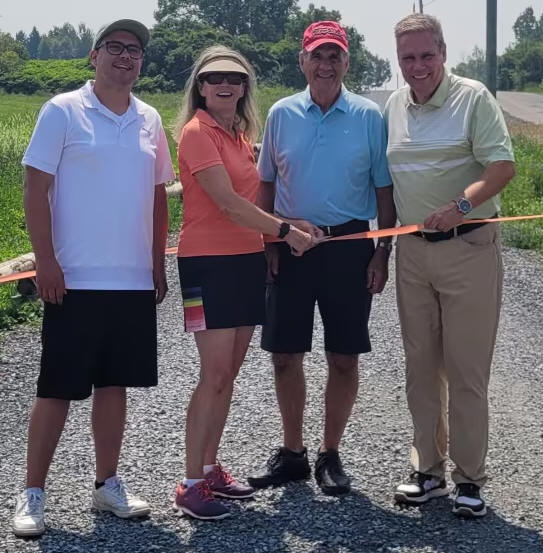The following
is an excerpt from
The Golfers' Journal, authored by Will Bardwell, written
after a visit to AVCC during the
2019 St. John Valley Amateur Labor Day
tournament.
Autumn comes early in Aroostook
County. More to the point, autumn comes first to Aroostook
County. As the northernmost county in New England's northernmost
state, winter's tidings naturally land here soonest. Summers are
usually mild; even in July, temperatures stay below 80 degrees
about as often as they go above it. Winters, of course, can be
brutal: The area received 60 inches of snow in January 2019
alone.
But in autumn, when the first brisk
wind blows across the border from Canada and the birch trees trade
in their green for orange, Aroostook County is a picture book.
And its dramatic hills make it a
breathtaking place for golf.
A small group of hearty New
Englanders founded Aroostook Valley Country Club in 1929 and built
their unassuming clubhouse mere feet beyond the United States'
border with Canada. But it wasn't the hills that inspired them—it
was alcohol. From 1920 to 1933, the 18th Amendment banned the sale
of liquor within the United States; in response, several golf clubs,
including Aroostook Valley, sprouted up in the borderlands, just to
the Canadian side of the line.
Today, nearly 90 years after Prohibition's
end, Aroostook Valley Country Club's members and visitors are here
for the remarkable golf course. That the golf course is here at all,
though, is proof that some people will do anything for a drink.
U.S. Highway 1 runs north,
tracing Maine's eastern border less than 3 miles away from Canada.
With the exception of the occasional farm or cemetery, the rolling
land is mostly undeveloped; the towns here are small and pass from
notice as quickly as they appear. At Mars Hill (population 1,400),
in far northeastern Maine, the highway breaks away from the border
and begins winding alongside the Aroostook River as it runs north
toward Caribou (population 7,600). At Caribou, Highway 1 and the
river part ways; the highway stretches northward toward what little
of America is left, but the river turns east toward the border.
Where the river turns east, so does one-lane Highway 89. The river
and the road continue together, past Fort Fairfield (population
3,300). The road winds on, past another cemetery and up one last
hill. At the edge of America, the driveway turns into Aroostook
Valley Country Club's parking lot. The car parks; its passengers
step out. And, somewhere in the spit of grass between the parking
lot and the clubhouse, at an invisible 5,500-mile-long line that
means nothing and yet means everything, the passengers immigrate
into Canada.
Here, on the line
separating the world's second-largest and fourth-largest countries,
it is easy to see why Aroostook Valley's founders would have deemed
it an ideal site for their retreat from the 18th Amendment. To call
this area “remote" would be to sell it short; the traveler drives
hours through the remote to get here. This place is farther north
than Geneva, Switzerland—one of the last areas in America that John
Q. Law would come looking for rabble. And if the isolation ever
proved too inadequate a barrier, the 18th Amendment's power ended
somewhere back around the parking lot. Aroostook Valley's members
always had the border on their side—the Feds' version of white
stakes.
After less than a decade and a half, America's experiment with
Prohibition ended in failure. Thankfully, the same is not true of
Aroostook Valley, nor of many of the borderland golf courses that
the era inspired. To be sure, Aroostook Valley Country Club (AVCC)
and the valley with which it shares its name are largely unchanged
by the past century. This corner of extreme northeast Maine is still
rugged and rural, still heavily dependent on potato farming. But
today, more than 90 years after its genesis, AVCC is more than just
a course on the border. It is an oasis of stunning, rollicking golf.
Some of the course's elements followed the Prohibition era: It
opened in 1929 as a nine-hole course, but by 1960 had grown to 18
holes under an expansion designed by Thompson's apprentice, Howard
Watson. (Watson, like his boss, was known for his fondness of brown
liquor —an appropriate quality for an architect laying out holes
just a bump-and-run outside of Prohibition's reach. Legend has it
that Watson once ordered a scotch and water at an American Society
for Golf Course Architects function, with very specific
instructions. “I prepared a very healthy drink for him, but he
quickly wrinkled his nose and pushed it back at me," the bartender
wrote. “He then had me get another glass and told me when to stop.
Well, I poured Scotch in this tall glass until it was about two
inches from the top. Howard then said. Top it oft' with water."')
Aroostook Valley's design still features the flattish sand traps
reminiscent of its era. In 1929, it was small and exclusive. (“The
membership," the Windsor Star newspaper reported that August, “is
limited to 150, after which it is not surprising, in view of the
varied attractions of borderland golf, to discover that there is a
long waiting list.") Today, Aroostook Valley is semi-private with
about 200 members, roughly half of whom are American and half are
Canadian.
  The meeting of these two countries is part of Aroostook Valley's
character. Both the Canadian and American flags fly above the first
tee and compose the club's logo; every few hundred feet, white
obelisks serve as border markers between the two countries. (One of
them stands prominently to the left of the first fairway, and a tee
shot pulled too far left on the first hole can begin in Canada and
finish in America.) An old, rusted sign near the pro shop commands,
“Avoid Penalty—Report to Customs—Vehicles Entering United States
Must Be Reported," and on the double green that serves as the
exclamation point for both the ninth and 18th holes fly two pin
flags: the Stars and Stripes and the Maple Leaf. The meeting of these two countries is part of Aroostook Valley's
character. Both the Canadian and American flags fly above the first
tee and compose the club's logo; every few hundred feet, white
obelisks serve as border markers between the two countries. (One of
them stands prominently to the left of the first fairway, and a tee
shot pulled too far left on the first hole can begin in Canada and
finish in America.) An old, rusted sign near the pro shop commands,
“Avoid Penalty—Report to Customs—Vehicles Entering United States
Must Be Reported," and on the double green that serves as the
exclamation point for both the ninth and 18th holes fly two pin
flags: the Stars and Stripes and the Maple Leaf.
But it would be a mistake to suggest that this course is a
borderland gimmick, or to confuse Aroostook Valley and the other
Prohibition-era borderland courses as outdated excuses to build
booze-friendly clubhouses. Aroostook Valley's routing climbs uphill
to stunning views of the valley below, then back through the ancient
forest and still farther down the hill before climbing
back up to begin the second nine, diving farther down into the
valley and then back around the hill to the clubhouse again, where
relief (in all its forms) awaits. The course's greens rarely sit
level with their approach shots, forcing the player into
uncomfortable and challenging guesswork. And the greens themselves
are full of creativity — tilted and contoured, but always fun.
 Each Labor Day weekend, the club hosts the St. John Valley Open, one
of the area's last amateur golf hurrahs before the elements send
local golfers hibernating until spring. The course's rambunctious
layout draws a wide diversity of ages and skill levels; the 2019
tournament's winner was more than twice the age of the final group's
youngest player. Golfers begin arriving on Tuesday for practice
rounds—many of them camping in tents along the practice green, just
narrowly on the Canadian side of the border—before tournament rounds
on Saturday and Sunday. Late in the afternoon each day during the
St. John Valley Open, the real party begins. Impromptu putting
matches break out on the practice green, a beer bottle or plastic
cup dotting the green's edge here or there while its owner lines up
his next shot. The air is just cool enough to whisper autumn's
approach. The sun eventually goes down; the golfers do not.
Flashlights and glow sticks keep the putting contests going, and
spirits do the same. It's not debauchery. But it's not boring,
either. It's an appropriate nod to Aroostook Valley's origins, and
it's not hard to understand why players from hours away return year
after year. Each Labor Day weekend, the club hosts the St. John Valley Open, one
of the area's last amateur golf hurrahs before the elements send
local golfers hibernating until spring. The course's rambunctious
layout draws a wide diversity of ages and skill levels; the 2019
tournament's winner was more than twice the age of the final group's
youngest player. Golfers begin arriving on Tuesday for practice
rounds—many of them camping in tents along the practice green, just
narrowly on the Canadian side of the border—before tournament rounds
on Saturday and Sunday. Late in the afternoon each day during the
St. John Valley Open, the real party begins. Impromptu putting
matches break out on the practice green, a beer bottle or plastic
cup dotting the green's edge here or there while its owner lines up
his next shot. The air is just cool enough to whisper autumn's
approach. The sun eventually goes down; the golfers do not.
Flashlights and glow sticks keep the putting contests going, and
spirits do the same. It's not debauchery. But it's not boring,
either. It's an appropriate nod to Aroostook Valley's origins, and
it's not hard to understand why players from hours away return year
after year.
AVCC History from 1930-2022
At Aroostook Valley Country Club
you will find the Stars and Stripes and the Maple Leaf flying side
by side - and why not - for here is a golf course that is
the success story of the combined efforts of members from
both sides of the border. The site was chosen on land
located a few miles from Fort Fairfield, Maine and near Four
Falls, New Brunswick. A nine hole course was laid out on the
Canadian side -- but so close to the border that a
right-hander's hooked ball on Number 1 or Number 9 went
right out of the country! They also chose the Canadian side
for the clubhouse, probably as Maine was in the throes of
prohibition. However, the parking lot was allocated for the
American side. On October 4, 1927 they applied for letters
patent. Renowned golf course designer, Howard K. Watson, was
commissioned to redesign the original 9-hole layout in 1959.
By 1960 the "new" 9 holes were ready and officially opened
when Slammin' Sammy Snead
played an exhibition match at AVCC. AVCC has also seen other
professional tour players play our course, including Babe
Zaharius
and 1990 PGA Player of The Year, Wayne Levi.
The first by-laws limited membership to 150 men--family
membership--wives and children between 16 and 21 years.
Associate membership to unmarried ladies over 21 or a
daughter or widow of a deceased member. A lady, if sponsored
by an unmarried male member, was entitled to the privileges
of the club for the current season. Members were elected by
secret ballot--two nays and he's out!! Membership quota was
Fort Fairfield 50, Presque Isle 40, Caribou 27,
Perth-Andover 10, Grand Falls 3, Washburn 4, un-allotted 10.
Dues were $40. The golf course was not opened to the ladies
on Sunday until 2:00 PM and players were warned not to drive
from the tee until players in front were past the distance
markers - 175 yards. In July, 1929 a meeting was held at the
clubhouse and a committee was given $5,000 to complete the
clubhouse, furnish it, complete the four tennis courts, and
grade the grounds. On August 26, 1929 they held their
official opening with an exhibition match between the pros
from Woodstock, Houlton, Saint John and Aroostook Valley.
The big celebration ended with a dance, music furnished by
the Ritz orchestra. The depression years were hard on the
club. It was decided to do without a pro and employ a
manager who would run the dining room and also collect the
green fees. Dues were reduced to $20, and a still greater
effort was made to encourage new members. One scheme was to
give complimentary passes to clergy in the area, another was
to see that all hotels had information about the course and
their guests could pay green fees without a member sponsor.
In 1933 the directors were delighted when the dance
committee showed a season's profit of $15. Homemade breads
and ice-cream were house specialties in the dining room and
gourmet Sunday dinners were 50 cents. By 1935 AVCC changed
its by-laws and opened the membership to anyone in the area
- associate membership to anyone living beyond a 35 mile
radius. Fees were now $30. Membership increased and in 1954
land was purchased to enlarge to an 18 hole course. After a
tremendous amount of work and cooperation from various
members and organizations, including Loring and Presque Isle
AFBs, the new course (one of the finest on both sides of the
border) was complete. By 1971 there were 316 playing members
and 54 social members. In 1976, under the chairmanship of
Gary Hatchard, AVCC hosted a 3-day, 54 hole Pro-Am event. It
was a great success and the eventual winner was Wayne Levi,
who, 14 years later, became the 1990 PGA Player of the Year.
AVCC is blessed with a tremendous staff and corps
of volunteers. We have made significant updates to our
facility with a tee-to-green irrigation system, a state of the art
POS computer system which includes an online tee time booking system
for our members and we added a new teeing area
to our practice tee. All these additions have been done with
relatively little increase in cost to play as a member or guest at
AVCC. In 2009 AVCC experienced huge changes. Due to the changing
world we live in and due to our most unique location, AVCC will not
continue to experience the relatively free access our US and
Canadian members and guests have enjoyed. US Homeland Security has
determined our location a border security problem and will now
require all US visitors to AVCC to enter the
US through a
Canadian manned port of entry
(please visit avcc.ca/access.htm).
This presents new challenges for AVCC. We have been fortunate for
the past 80 years as a country club and will face this challenge
head on, continuing to offer our members and guests the same
professional service they have grown accustomed to. AVCC celebrated
its 80th anniversary in 2009.
In the spring of 2012, the
replacement of the 15 casement windows in our clubhouse was
initiated. The former 40 year old windows were replaced with energy
efficient windows. The project was started by member and director
Jeff Murchison and member Himie Towle III. Through their efforts and
the generous contributions of many, financial and otherwise, the
success of this project was realized in short time.
On Friday, June 29, 2012, AVCC was hit hard by a violent
thunderstorm and microbursts. Approximately 200 trees were lost and
a substantial amount of damage was inflicted on the clubhouse, Pro
Shop and cart sheds. Fortunately, the damage was restricted to AVCC
property. The 20 or so members and employees present were unharmed,
although shaken by the experience. As always the staff and
membership of AVCC immediately responded and the course was playable
within two days. It will be during the 2013 season before AVCC fully
recovers from Mother Nature's wrath as fallen trees are removed,
cart shed(s) rebuilt and/or repaired.
Of all the hardships AVCC
has faced over the years, 2020 will likely go down as our largest
threat. As the COVID pandemic hit home in March 2020, our unique
location along the Maine-New Brunswick international border has
proven to be problematic. Respective US and Canadian government
departments have seen fit to totally transform how our American and
Canadian members and guests are to access AVCC. The affect of this
decision has reduced our membership by nearly 50% and our total
annual revenue by substantially more. We continue to carry on with
determination to survive and restore some semblance of past
normalcy. Our core membership and a huge contingent of friends of
AVCC have supported our efforts.
......fast
forward to 2025
How a long U.S.
border headache came to an end for Aroostook Valley CC
A two-decade-long border
security headache is finally over for a New Brunswick golf course
tucked up against the U.S. border in the rolling hills of Victoria
County. Canadian golfers now have a safe, legal and all-Canadian
route to the picturesque Aroostook Valley Country Club near
Perth-Andover. "The future of our club is back and very bright, and
the club is vibrant," said Stephen Leitch, the AVCC Club Manager and
CPGA Professional.
 Leitch
credits a Canadian family that itself had to put up with the U.S.
crackdown on the once-relaxed border area. "I just went, 'You know
what — this is never going to change,'" said Mary Pedersen, a
Fredericton physician who grew up down the road — the American road
– from the course. "So I said, 'I'll donate the land.' Pedersen and
her family transferred a strip of land running along the Canadian
side of the border to create a trail that golfers use to shuttle
into and out of the course on golf carts.The trail is named for her
parents, Nickolaj and Marion Pedersen, who lived on the same
road.The travails of the golf course, and the Leitch
credits a Canadian family that itself had to put up with the U.S.
crackdown on the once-relaxed border area. "I just went, 'You know
what — this is never going to change,'" said Mary Pedersen, a
Fredericton physician who grew up down the road — the American road
– from the course. "So I said, 'I'll donate the land.' Pedersen and
her family transferred a strip of land running along the Canadian
side of the border to create a trail that golfers use to shuttle
into and out of the course on golf carts.The trail is named for her
parents, Nickolaj and Marion Pedersen, who lived on the same
road.The travails of the golf course, and the
 Pedersens,
made headlines in the years after the 9/11 terrorist attacks in 2001
prompted U.S. authorities to declare an "Orange Alert" security
level along the Canada - U.S. border.For decades, Canadian golfers,
and people heading to the Pedersen home, turned left onto the
Russell Road, which follows the north-south border line.The road is
entirely within U.S. territory in front of the Pedersen homestead
and the club, but pre-9/11, Canadians didn't need to check in with
U.S. authorities to drive there.Golfers would park in a club parking
lot on the U.S. side of the border and walk to the clubhouse in
Canada — another technically illegal crossing.
After 2001, security officials became less willing to tolerate
that. The Pedersens endured U.S.
border patrol enforcement against family members, mail carriers and
newspaper carriers. Marion died in 2004 and Nick in 2009. Golfers,
meanwhile, began making a time-consuming detour through the official
U.S. entry point at Fort Fairfield, Maine, to get to the club.But
the border shutdown during the COVID-19 pandemic put an end to that
work-around, leaving Leitch wondering if the club could survive.
There were jobs on the line, and actually the lifeline of the golf
club was on the line," he said.
"What was once very
advantageous to us in the way we were able to draw, in a very rural
area, golfers from both sides of the border … has been met with some
challenges, the fact that people aren't able to access the golf club
the way they once were. "For a while, golfers would come down a back
road through a potato field to the Pedersen property, with
permission from the field's owner, Grand Falls-based Dubé Farms.
From there they'd shuttle to the club in golf carts zipping down the
shoulder of the Russell Road, hugging Canadian territory. "It was
not ideal," said Lynn Dooling, the reigning women's champion at the
club. Leitch calls it "a bad situation in the way that we were
driving against traffic, on a blind hill, and probably doing harm to
the edge of the road." Leitch asked Pedersen for help, and she
decided to transfer the land for a trail running along the Russell
Road a few feet within Canada. It created a happy ending for the
tiny Canadian community of neighbours on this U.S. road."We grew up
together. It was heartbreaking seeing all that happen," Pedersen
said of the 20-plus years of hassles."I just feel really, really
happy giving this land to them. I know Mum and Dad would have been
extremely happy to see it." Pedersens,
made headlines in the years after the 9/11 terrorist attacks in 2001
prompted U.S. authorities to declare an "Orange Alert" security
level along the Canada - U.S. border.For decades, Canadian golfers,
and people heading to the Pedersen home, turned left onto the
Russell Road, which follows the north-south border line.The road is
entirely within U.S. territory in front of the Pedersen homestead
and the club, but pre-9/11, Canadians didn't need to check in with
U.S. authorities to drive there.Golfers would park in a club parking
lot on the U.S. side of the border and walk to the clubhouse in
Canada — another technically illegal crossing.
After 2001, security officials became less willing to tolerate
that. The Pedersens endured U.S.
border patrol enforcement against family members, mail carriers and
newspaper carriers. Marion died in 2004 and Nick in 2009. Golfers,
meanwhile, began making a time-consuming detour through the official
U.S. entry point at Fort Fairfield, Maine, to get to the club.But
the border shutdown during the COVID-19 pandemic put an end to that
work-around, leaving Leitch wondering if the club could survive.
There were jobs on the line, and actually the lifeline of the golf
club was on the line," he said.
"What was once very
advantageous to us in the way we were able to draw, in a very rural
area, golfers from both sides of the border … has been met with some
challenges, the fact that people aren't able to access the golf club
the way they once were. "For a while, golfers would come down a back
road through a potato field to the Pedersen property, with
permission from the field's owner, Grand Falls-based Dubé Farms.
From there they'd shuttle to the club in golf carts zipping down the
shoulder of the Russell Road, hugging Canadian territory. "It was
not ideal," said Lynn Dooling, the reigning women's champion at the
club. Leitch calls it "a bad situation in the way that we were
driving against traffic, on a blind hill, and probably doing harm to
the edge of the road." Leitch asked Pedersen for help, and she
decided to transfer the land for a trail running along the Russell
Road a few feet within Canada. It created a happy ending for the
tiny Canadian community of neighbours on this U.S. road."We grew up
together. It was heartbreaking seeing all that happen," Pedersen
said of the 20-plus years of hassles."I just feel really, really
happy giving this land to them. I know Mum and Dad would have been
extremely happy to see it." 
The club held a
ribbon-cutting ceremony for the trail with Mary and her son, Mark
along with AVCC Club President, Pat St. Peter and AVCC Pro-Manager,
Steve Leitch in July. "It made all the difference for them to donate
this land and be able to build this road and drive straight out to
the club house," Dooling said. "It's just been
phenomenal." Americans, who used to make up about half of the club's
membership, are now the ones who must cross the border through a
legal checkpoint and take the long way around to the club.Leitch
said this has affected membership numbers among Maine residents near
the club, but business is good for American green-fee golfers —
visitors to the state who come up to experience the novelty of the
course and its scenic location for a day or two. As he prepares for
the club's centennial celebrations in 2029, Leitch said the oddity
of the setting, and the unusual way of getting there, could become
part of the appeal. "There's not that many places where you have to
shuttle in to the golf course over that distance on a golf cart to
play such a beautiful course," he said."But
when you come up over the hill after driving through that potato
field, and you wonder to yourself, 'Where in the heck are we going,'
and … you see this oasis, you say, 'Oh, this is why' and that's
exactly what's happening. People are finding a charm in that."
Jacques Poitras, Provincial
Affairs reporter
|